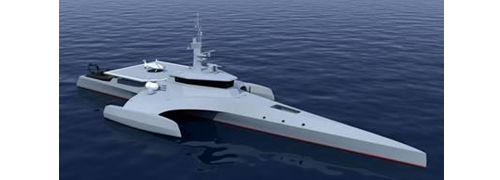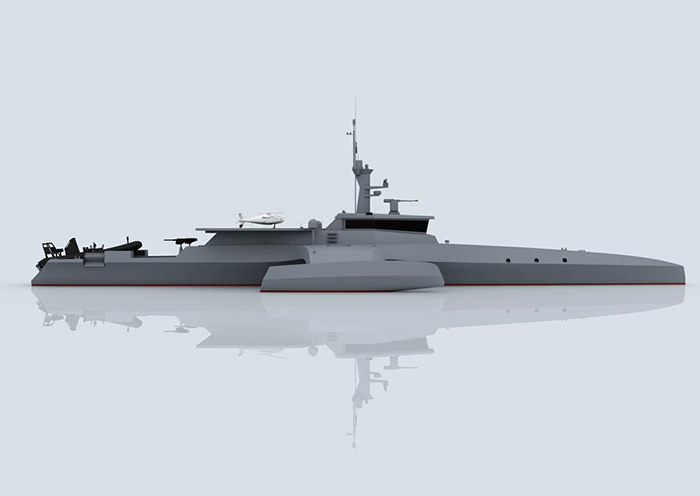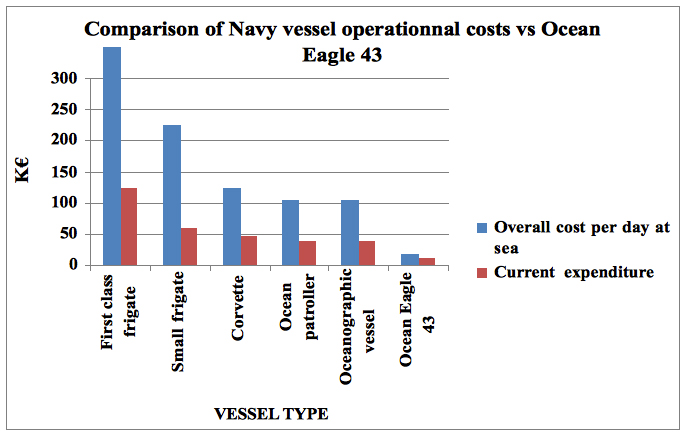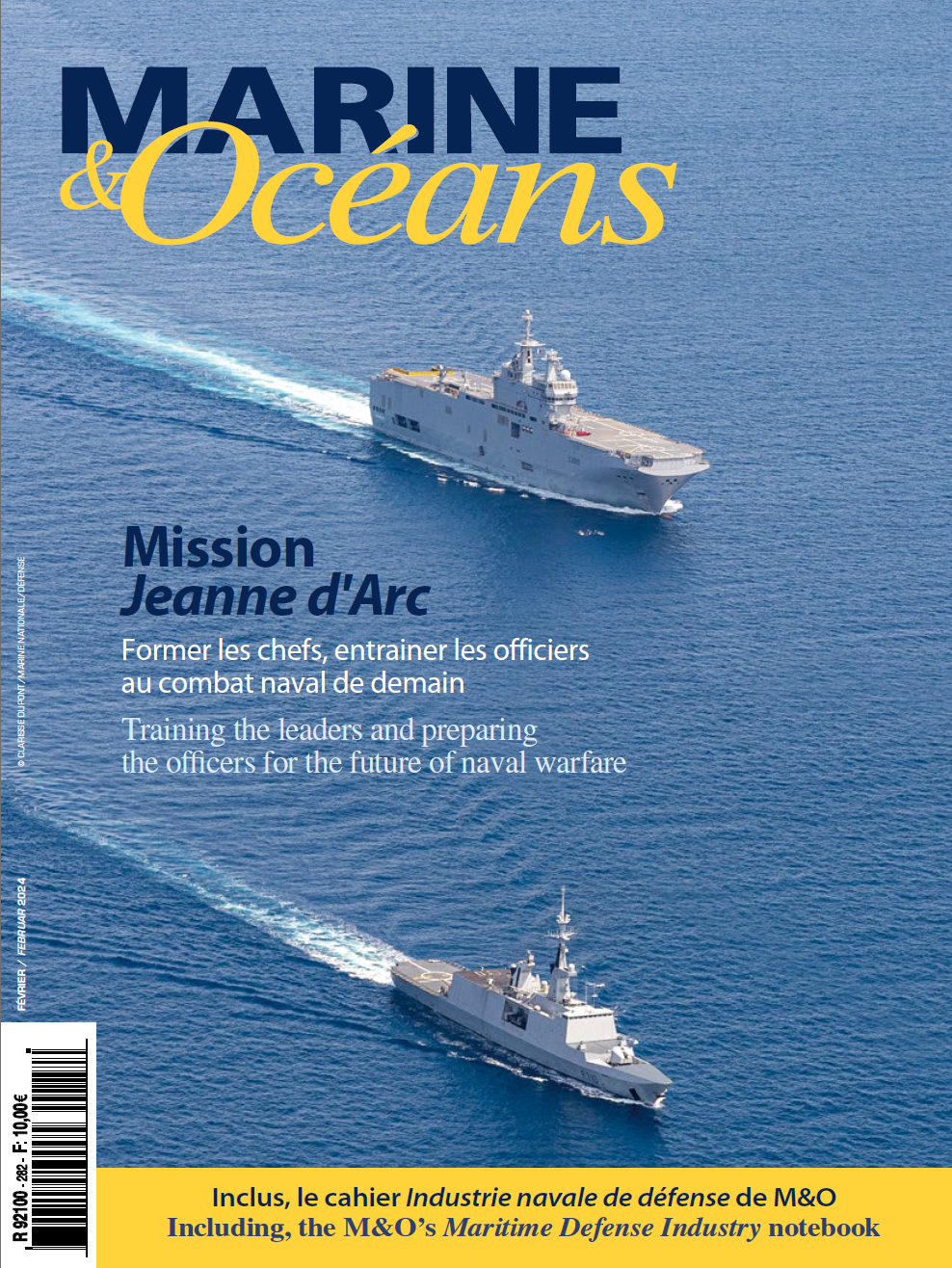The Ocean Eagle story began in 2012 when ProLarge, a company specialised in the design and operation of sea-based projects (www.prolarge.fr), and SeaTeam Aviation, an air-marine services company, proposed a joint venture to CMN. Its goal was to produce a fast, light but reliable patrol trimaran using innovations developed for ocean racing, a field in which many French sailors had excelled. Strongly linked by their common trust and professionalism, the three companies were soon joined by the naval architect Nigel Irens, father of the multi-hulls Brigitte Bardot1 and Ilan Voyager.
This Dream Team then started to develop an operational tool inspired by ocean-going racing vessels, able to fulfill the present ever increasing need for sovereign sea-space surveillance.
Indeed, the world’s oceans are at the heart of modern economy. More than 90% of world trade – the growth trend of which is doubling every 10 years – is transported by sea. Furthermore, the marine environment offers the fishing, energy, mineral and biological resources that a country can no longer afford or wish to ignore.
At the same time, seas are becoming more dangerous and threats on freedom of trade and State sovereignty are constantly increasing. Due to the lack of financial resources, many governments are unable to find satisfactory answers to this environment, which weakens them while the need for action at sea is becoming more acute.
New solutions were needed, in particular, new types of vessels, corresponding to countries requirements in a financially tight context. Bearing this in mind, CMN, ProLarge, SeaTeam Aviation and Nigel Irens Design pushed the concept of the OPV (Offshore Patrol Vessel) to its limits.
Their purpose was clear: to design and build a suitable tool for missions of sea patrol and control enforcement over large areas and for long periods of time, accessible to States deprived of the capacity to invest hundreds of millions in one vessel, indispensable as it may be.
Nowadays, a Navy must indeed be able to carry out multiple missions, many of them low intensity ones : fishery surveillance, security of critical trade lines, search and rescue, prevention of asymmetrical risk, policing of illegal immigration, naval training back-up, medical assistance to island and coastal inhabitants, public service and inter-island, marine environment and protected areas monitoring , security and support for scientific surveys, air surveillance of maritime areas and many more.
These missions all have one common point : the need to coordinate air and sea vectors in order to fully assert a country’s sovereignty over its maritime domain. To do so, the gridding of the monitored area must be effective. Taking appropriate action at the proper level, implies combining air surveillance means with those of surface response while being able, if pertinent, to prepare heavier means implementation for more elaborate actions. Budgetary constraints require these missions to be carried out at the best price/performance ratio.
Thus, for CMN and its partners the principal aim of this multihull ocean patrol vessel was to obtain a much lower cost of ownership than the leading single-hull ship qualified for the same low intensity missions, and without concession on the operational performance requirements.
Dividing this cost ten times, meanwhile breaking with the “standard” conventions of traditionally oversized ships would have been a pipe dream without a whole series of technological breakthroughs. Substantial technical and cultural challenges needed to be overcome to achieve a low displacement vessel at relatively low cost, offering the long lines of an ocean racer, high action potential and a sustainable speed of 30 knots.
The solution took the streamlined shape of a Polynesian canoe stabilised by two lateral floats, but in order to achieve this, the issues of weight, structural strength and platform motion had to be resolved. Weight is the enemy of performance on a multihull vessel required to go fast and far, and the first necessity of a ship, sturdiness, does not always coincide with low weight. The balance between these two factors was the first problem which had to be solved in order to avoid over-sizing.
At the same time it was necessary to define a coherent concept of use for this type of vessel, to put this concept into line with operational requirements and then implement technological advances from the bold world of ocean racing to far more conservative naval applications. Thus, Ocean Eagle43 was the result of elaborate hydrodynamic studies but also of the experience of Nigel Irens and the shipbuilding know-how of CMN. A highly pragmatic operational approach nurtured the capacity to adapt the configuration to the mission profile while keeping within a range of optimised performance with regard to the work to be carried out.
Another key objective was reliability and ease of maintenance. Surveillance missions do not require weapons and sensors calibrated for the “next world war”, but straightforward efficient systems which are easily serviced. A patrol vessel should most certainly not remain moored because of technical complications which cannot be managed by the operator. This demand for reliability led to a challenge which became an essential feature of the vessel; the possibility for a main propulsion engine to be changed in less than 24 hours.
The OE43 has in fact been the source of many cultural innovations and developments. The first was something quite unusual for a shipyard : CMN gave substance to the idea that added value could be better achieved through effective customer service rather than by piling on state of the art technology which was often quite space consuming.

Ocean Eagle 43 has replaced the age-old rule of “too much has never failed” with “what’s needed when it’s needed”. Hence the very modular ship design which enables it to fulfil such varied missions such as the fight against piracy, smuggling and terrorism, search and rescue, policing of fisheries, study and monitoring of the marine environment, special operations support, mine-sweeping and so on. The ability to carry out all these missions simultaneously could easily increase the overall vessel expenditure from 10 to 30; but actually, would this be cost effective?
Nowadays, the means of information processing and dissemination allow us to know precisely what we will or will not encounter at sea. Therefore, is it really necessary to continuously increase capability ? That of the OE43 is based on aeronautical technology, with dedicated equipment which can be adapted to each type of mission in the appropriate configuration.
Another aspect adopted from aeronautics is in the piloting technique; the OE43 crew must manage remaining fuel levels in relation to mass in the same way as an aircraft pilot. A balance point has to be maintained between speed, range and onboard capability.
The purpose of this patrol vessel requires certain state of the art equipment to be incorporated without it constituting a technological bind: fixed or rotary wing UAVs on a small launch pad, high performance RHIB, optical and radar sensors, air-sea radio transmission of satellite data (overcoming the sensitive issue of electromagnetic compatibility on a small craft) and a medium calibre remote controlled gun turret.
Finally, careful consideration had to be given to human factors, particularly psychological, and efforts were made to remain within the blueprint of what is statistically tolerable in terms of a ship’s motion.
With these formidable assets there are great ambitions for the OE43. It can bring concrete policy support for European cooperation by providing certain coastal countries with a turnkey ability for intervention at sea. The vessel was designed to support European programmes such as the MASE (Regional Maritime Security Programme) and the RMCB (Regional Maritime Capacity Building) which aim to develop regional means, to strengthen the role of governments and international organisations at sea and to promote a viable alternative to the privatisation of sea security. The extremely low consumption of the OE43 (about 2 tonnes of fuel per day at economy speed), means that user States can demonstrate their respect for the environment.
The OE43 will finally allow countries with navies to devote their high seas forces to military missions and avoid consuming their potential on surveillance tasks which, in many cases moreover, they do not have the means to ensure.
In addition to its principal task of maritime surveillance, the OE43 would also be able to perform certain scientific assignments of coastal and oceanic nature. Indeed, the stability of a multihull platform offers many advantages and numerous geographical and oceanic sensors are now available in a size and weight compatible with smaller ships.
Making available a workspace connected to a data acquisition system to a team of scientists and offering them a compact installation for carrying out their technical assignments will qualify the vessel for certain survey missions. These could include the operation of towed HF sonar for seabed reconnaissance, establishing seabed features through use of multi-beam echo sounding, towing and implementation of lightweight geophysical systems, operating ROV and/or AUV, drawing up CTD profiles (Conductivity Temperature Depth), deployment of oceanic drift sensors and profilers, observation of marine life, and so on.
It also seems obvious that the OE43 will be particularly appropriate for the support of certain low intensity scientific campaigns in so-called “zones of risk” such as the Indian Ocean and the Gulf of Guinea. Specialised oceanographic vessels capable of answering these needs exist but their high operating cost often makes their use prohibitive for “light” oceanic missions. Thus, numerous genuine requirements remain unanswered due to the lack of affordable solutions and this is where the Ocean Eagle 43 comes into its own; its very purpose is to answer, at the lowest possible cost, to all existing needs in terms of maritime surveillance and exploration. The sale of the first three units to Mozambique highlights the launching of a wonderful industrial, maritime and human adventure.
Contacts CMN:
51, rue de la Bretonnière
BP 539
50105 Cherbourg
France
Phone : +33 (0) 1 42 56 33 14
ProLarge / Seateam Aviation : info@prolarge.fr
Ocean Eagle 43 :
A light, fast and durable sea patrol trimaran.

Ocean Eagle 43 – 43 metres long for only 75 tonnes – is a highly modular vessel of astonishing performance: a range of 3 000 nautical miles (5 556km) at 18 knots, 1 700 nautical miles (around 3 200km) at 30 knots and the possibility to cover 5 000 nautical miles (nearly 9 300km) at economy speed. The OE43 is designed to carry a 300kg class UAV (e.g. the Schiebel Camcopter S-100), a 7 metre response RHIB, a team of commandos, radar and optical sensors and a telecommunications system. It is also has class IV ballistic protection on the wheelhouse, a 20 to 30 mm remote controlled cannon (configuration successfully tested by CMN on a 15 metre DV15 RWS interceptor), a satellite data link enabling transmission of image, video and tactical information to a land base or other vessels, a combat system interface (CMS) and an integrated navigation system (INS).
Four Key Competitive Advantages
-
An unprecedented ratio of “area patrolled + performance / cost per square nautical mile covered”: in the range of 25 000 square nautical miles in 5 days at 18 knots,
-
Straightforward maintenance,
-
A Low carbon footprint: 238 nautical miles at 15 knots with one tonne of fuel as opposed to 50 nautical miles at the same speed for a small ocean patroller of 50 metres length (450 tonne class),
-
High modularity.
Unprecedented performance / cost ratio

1 Brigitte Bardot, formerly Cable & Wireless Adventurer, held the world record for circumnavigation in 1998.



